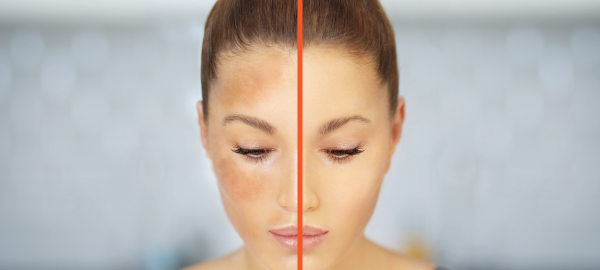Dark patches on the skin are one of the most common concerns we hear about. Many people assume it’s all “sun damage” — and often it is. But sometimes, pigmentation can be driven by other factors, like hormones. Understanding the difference can help set realistic expectations about what skincare can (and can’t) do.
Sun Damage Pigmentation
When your skin is exposed to the sun, it makes extra pigment (melanin) to protect itself. Over time, this builds up and shows as freckles, sunspots, or patchy areas of darker skin. This process is slow and cumulative — sun damage can keep appearing years after the original exposure. That’s why daily sunscreen is so important, even when you’re already working to improve your skin.
What About Melasma?
Melasma is another common type of pigmentation. It often looks like larger, patchy areas on the face, and it’s more common in women. Unlike sun damage, melasma is usually linked to hormones — pregnancy, contraceptives, or other hormonal changes. Melasma can look very similar to sun damage, which is why it’s important to see a GP or skin professional if you’re unsure.
Can You Have Both?
Yes. Many people have a mix of sun damage and melasma, which can make pigmentation more persistent.
Where Vitamin B3 Fits In
Vitamin B3 (niacinamide) is scientifically proven to reduce the transfer of pigment into new skin cells, which makes it a powerful ingredient for supporting skin affected by both sun damage and melasma.
But it’s important to understand its limits:
- With sun damage: B3 can help fade the appearance of dark spots and strengthen the skin barrier — but you’ll still need to protect your skin from further UV exposure with daily sunscreen.
- With melasma: B3 can help soften the appearance of patches — but it won’t stop hormones from triggering new ones. For that, it’s best to speak with a GP or dermatologist.
Adding Other Actives
B3 isn’t the only active ingredient that helps hyperpigmentation. Others include tranexamic acid, arbutin, azelaic acid, vitamin C, or prescription treatments like hydroquinone. However, the reason we have centred our products on Vitamin B3 is that it’s a powerhouse multi-tasker. Also known as niacinamide, Vitamin B3 also strengthens the skin barrier, supports hydration, and layers well alongside other actives — some of which can be harsh. Using a B3 product alongside them can make these treatments easier to tolerate by keeping the skin more resilient.
Don’t Forget Sunscreen
Whatever the cause of hyperpigmentation, daily sunscreen is essential.
- For sun spots (sun damage): Sunscreen helps prevent new spots from appearing and stops existing ones from becoming darker.
- For melasma: While hormones are the root cause, light exposure is one of the biggest triggers that can worsen melasma patches. Both UV and visible light — especially blue light — may contribute. That’s why sunscreen is still recommended, and some dermatologists suggest tinted formulas (or layering makeup containing iron oxides), since these protect against both UV and visible light.
Getting a Diagnosis
The good news is diagnosis doesn’t have to be complicated. A GP, skin cancer clinic, or dermatologist can usually tell whether pigmentation is sun damage, melasma, or both — and guide you on the best approach.
Other Causes of Pigmentation
While sun damage and melasma are two of the most common types, pigmentation can also come from acne or eczema (post-inflammatory marks), certain medications, or underlying health conditions. That’s why speaking with a health professional is always recommended if you’re unsure. The good news? You don’t have to overcomplicate things. A consistent routine built around Vitamin B3 and daily sunscreen can make a visible difference.
About SolarCareB3
Developed by Australian doctors and pharmacists, SolarCareB3 is a skincare range centred on research-backed levels of Vitamin B3 (niacinamide). Our products are designed to support sun-damaged skin and help reduce the visible effects of pigmentation — all while strengthening the skin barrier for healthier, more resilient skin.
